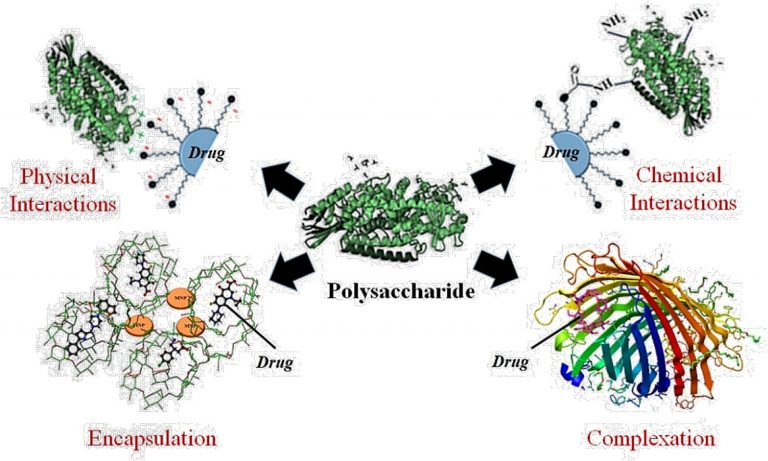What is a Nano-Drug Delivery System of Natural Polysaccharides

Posted by RichardG111
from the Health category at
08 Sep 2023 01:54:53 am.

Figure 1. Current-status and applications of polysaccharides in drug delivery systems.
Preparation Principle and Method of Natural Polysaccharide Nano-Delivery Carrier
According to the properties of natural polysaccharides and the types of drugs to be loaded, the preparation methods of natural polysaccharide nano-delivery carriers are mainly divided into two categories: one is the top-down method, that is, from the large to the small method, the particle size at the macroscopic level is reduced from large polysaccharide molecules to smaller particle sizes through the action of mechanical force; the second is the bottom-up method, that is, from the miniaturization method, on the basis of molecules and atoms, through electrostatic interactions or chemical bonds between molecules and colloids allows the polysaccharide polyelectrolyte to form a copolymer. Since the bottom-up method is to ideally control the nano-delivery carrier on a molecular or atomic basis, in order to obtain a carrier material that is more suitable for research purposes, it can be used as a popular technology for the preparation of nano-delivery carriers. The specific methods can be divided into cross-linking method, self-assembly method, etc.
Cross-Linking Method
Polysaccharide macromolecules can form copolymers by ionic bonds with oppositely charged substances through electrostatic interactions, and can also form copolymers by combining active groups on polysaccharide molecular chains with multifunctional compounds through covalent bonds. Collectively referred to as the cross-linking method.
Self-Assembly Method
Polysaccharide macromolecules can spontaneously form stable and ordered nanostructures through non-covalent interactions, including nanoparticles, nanocapsules, micelles, nanotubes, and nanorods.
Nano-drug delivery system based on natural polysaccharides
Excellent biological activity, safety and degradability make natural polysaccharides have great research potential, and in the field of medicine, natural polysaccharides also have pharmacological effects such as immune regulation, anti-tumor, anti-oxidation and anti-virus. Whether it is used as a nano-carrier or an active drug, natural polysaccharides are favored, and the combination with nanotechnology is the frontier development direction of its high-value application development. The nano-delivery system includes two aspects: the nano-delivery carrier and the nano-particles of the drug itself. There are many kinds of natural polysaccharides. Here, the research progress of nano-delivery systems for polysaccharides from several major sources, such as fungal polysaccharides, plant polysaccharides, animal polysaccharides, bacterial polysaccharides and algae polysaccharides, will be elaborated.
Nano-Delivery System Constructed from Fungal Polysaccharides
Fungal polysaccharides are derived from edible and medicinal fungal plants, mainly including exopolysaccharides and intracellular polysaccharides, most of which are heteroglycans in the β-configuration. Fungal polysaccharides have outstanding immunomodulatory, antitumor, and antibacterial activities, but they have disadvantages such as large relative molecular weight, high viscosity, and poor water solubility in vivo. Fungal polysaccharides can be used as drug molecules to participate in the construction of nano-drug delivery systems, thereby improving water solubility, bioavailability, and efficacy of fungal polysaccharides. They can also be used as nano-delivery carriers to improve the targeting, stability, and pharmacokinetics of loaded drugs.
Nano-delivery System Constructed from Plant Polysaccharides
Plant polysaccharides are the most widely studied natural polysaccharides, which are composed of monosaccharides linked by α- or β-glycosidic bonds. According to different sources, they can be divided into flower, fruit, stem and leaf, and rhizome polysaccharides. Plant polysaccharides have anti-tumor, immune regulation, anti-oxidation and anti-radiation effects, but they are easily degraded by gastric acid or digestive enzymes in the body when taken directly, and it is difficult to penetrate the blood-brain barrier. The combination of plant polysaccharides and nanotechnology can not only exert the activity of polysaccharides, but also act as a drug delivery carrier for slow and controlled release or targeted positioning.
Nano-delivery System Constructed from Animal Polysaccharides
Animal polysaccharides are mainly derived from the organs and connective tissues of animals, and can bind to receptors of various cells for targeting mediation; they can also form hydrogen bonds with the gastrointestinal mucosa, directional retention, and are often used in nano-delivery systems. Used as a nano-delivery carrier material. Animal polysaccharides have significant anticoagulant and antitumor activities, and can also be used as active drugs and various nano-delivery carriers to construct nano-drug delivery systems.
Nano-delivery System Constructed from Bacterial Polysaccharides
Bacterial polysaccharides are the main components of bacterial cells, which can be divided into cell wall polysaccharides, exopolysaccharides and intracellular polysaccharides according to different forms. Because it can mediate the recognition and adhesion of pathogenic bacteria to the host, it is mostly used as a nano-delivery carrier in the field of nanotechnology, and is used in the preparation of polysaccharide vaccines, diagnostic reagents and other immune drugs; its excellent antibacterial and anti-tumor activities are also further applied to nanoparticles, nanogel and other nano-delivery system development.
Nano-delivery System Constructed from Algal Polysaccharides
Algal polysaccharides are mainly derived from the intracellular and intercellular of algal plants, and have a wide range of pharmacological effects. Because of its hydrophilicity and low immunogenicity, it can avoid the recognition and adsorption of plasma proteins, and its gelatinity and easy modification can be used for slow and controlled release and targeted drug delivery. It is often used as a nanoparticle in the pharmaceutical field delivery vehicle. At the same time, the new nano-delivery carrier is equipped with natural algae polysaccharides, which can be applied to the preparation of nano-delivery systems with antibacterial, antioxidant and anti-tumor effects.
Tags: Polysaccharides
1 Comments
Comments




Fnaf